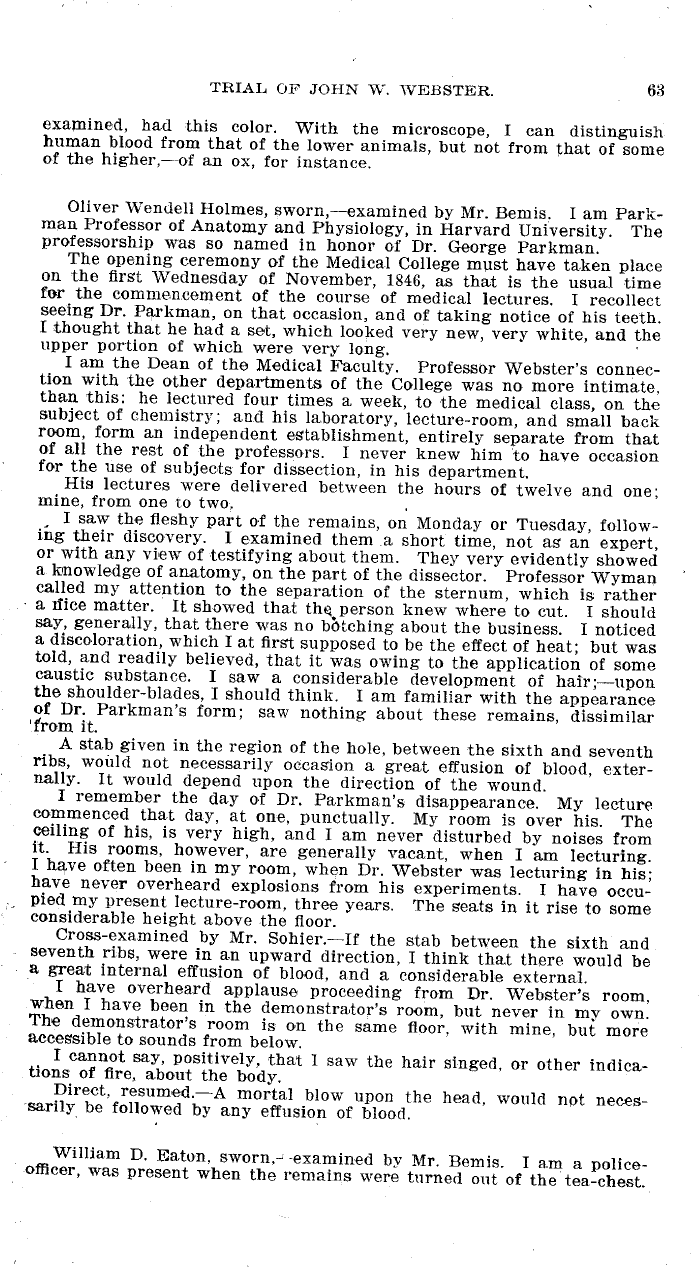|
TRIAL Oh JOHN W. AVEBSTER. 63
examined, had this color. With the microscope, I can distinguish
human blood from that of the lower animals, but not from that of some
of the higher,--of an ox, for instance.
Oliver Wendell Holmes, sworn,-examined by Mr. Bemis. I am Park-
man Professor of Anatomy and Physiology, in Harvard University. The
professorship was so named in honor of Dr. George Parkman.
The opening ceremony of the Medical College must have taken place
on the first Wednesday of November, 1846, as that is the usual time
for the commencement of the course of medical lectures. I recollect
seeing Dr. Parkman, on that occasion, and of taking notice of his teeth.
I thought that he had a set, which looked very new, very white, and the
upper portion of which were very long.
I am the Dean of the Medical Faculty. Professor Webster's connec-
tion with the other departments of the College was no more intimate,
than this: he lectured four times a week, to the medical class, on the
subject of chemistry; and his laboratory, lecture-room, and small back
room form an independent establishment, entirely separate from that
of all the rest of the professors. I never knew him 'to have occasion
for the use of subjects for dissection, in his department.
His lectures were delivered between the hours of twelve and one;
mine, from one to two,
I saw the fleshy part of the remains, on Monday or Tuesday, follow-
ing their discovery. I examined them a short time, not as an expert,
or with any view of testifying about them. They very evidently showed
a knowledge of anatomy, on the part of the dissector. Professor Wyman
called my attention to the separation of the sternum, which is rather
a nice matter. It showed that the person knew where to cut. I should
say, generally, that there was no botching about the business. I noticed
a discoloration, which I at first supposed to be the effect of heat; but was
told, and readily believed, that it was owing to the application of some
caustic substance. I saw a considerable development of hair; upon
the shoulder-blades I should think. I am familiar with the appearance
of Dr. Parkman's form; saw nothing about these remains, dissimilar
'from it.
A stab given in the region of the hole, between the sixth and seventh
ribs, would not necessarily occasion a great effusion of blood, exter-
nally. It would depend upon the direction of the wound.
I remember the day of Dr. Parkman's disappearance. My lecture
commenced that day, at one, punctually. My room is over his. The
ceiling of his, is very high, and I am never disturbed by noises from
it. His rooms, however, are generally vacant, when I am lecturing.
I have often been in my room, when Dr. Webster was lecturing in his;
have never overheard explosions from his experiments. I have occu-
pied my present lecture-room, three years. The seats in it rise to some
considerable height above the floor.
Cross-examined by Mr. Sohier.-If the stab between the sixth and
seventh ribs, were in an upward direction, I think that there would be
a great internal effusion of blood, and a considerable external.
I have overheard applause proceeding from Dr. Webster's room,
when I have been in the demonstrator's room, but never in my own.
The demonstrator's room is on the same floor, with mine, but more
accessible to sounds from below.
I cannot say, positively, that I saw the hair singed, or other indica-
tions of fire, about the body.
Direct. resumed.-A mortal blow upon the head, would not neces-
sarily, be followed by any effusion of blood.
William D. Eaton, sworn,--examined by Mr. Bemis. I am a police-
officer, was present when the remains were turned out of the tea-chest.
|

